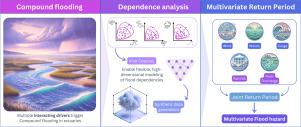河口复合洪水分析的多变量设计事件
IF 4.5
2区 工程技术
Q1 ENGINEERING, CIVIL
引用次数: 0
摘要
了解河口的复合洪水(CF)危险需要超越单变量方法,转向捕获多个驱动因素共同行为的多变量框架。尽管人们越来越认识到这些方法的相关性,但大多数现有方法仍然局限于双变量分析。扩展到更高的维度带来了概念和计算上的挑战,特别是在估计联合返回期(JRP)和定义代表性设计事件方面。这种限制在河口系统中尤其重要,在河口系统中,危险可能是由相互作用的驱动因素(包括降水、河流排放、风暴潮和波浪)共同作用造成的,而这些驱动因素很少单独发生。在这种情况下,将分析限制为两个变量可能会忽略相关的依赖关系,从而加强了对考虑高阶交互的模型的需求。本研究在一个六维案例研究中考察了多变量依赖结构的作用,比较了不同的copula家族,以评估其对CF危害分析的适用性。以Santoña河口为例,评估了模型选择如何影响联合事件的估计和设计代表性条件的选择。在探索的模型中,包含极值连词的藤结构导致了更连贯的联合估计,在依赖场景中提供了更好的稳定性。该分析不是寻求一个普遍的最优模型,而是说明了依赖结构的选择如何影响联合极值的表示。提出的框架支持物理解释和统计一致的多变量设计事件,用于沿海环境中的复合危害分析。本文章由计算机程序翻译,如有差异,请以英文原文为准。

Multivariate design events for compound flooding analysis in estuaries
Understanding Compound Flood (CF) hazard in estuaries requires moving beyond univariate approaches toward multivariate frameworks that capture the joint behavior of multiple drivers. Although the relevance of such approaches is increasingly recognized, most existing methods remain limited to bivariate analyses. Extending to higher dimensions poses conceptual and computational challenges, particularly in estimating Joint Return Periods (JRP) and defining representative design events. This limitation is especially relevant in estuarine systems, where the hazard may result from the combined action of interacting drivers — including precipitation, river discharge, storm surge, and waves — that rarely occur in isolation. In this context, restricting the analysis to two variables may overlook relevant dependencies, reinforcing the need for models that account for higher-order interactions.
This study examines the role of multivariate dependence structures within a six-dimensional case-study, comparing different copula families to evaluate their suitability for CF hazard analysis. Focusing on the Santoña estuary, we assess how model choice influences the estimation of joint events and the selection of representative conditions for design. Among the models explored, vine constructions incorporating extreme-value copulas led to more coherent joint estimates, offering improved stability across dependence scenarios. Rather than seeking a universally optimal model, the analysis illustrates how the choice of dependence structure can influence the representation of joint extremes. The proposed framework supports physically interpretable and statistically consistent multivariate design events for compound hazard analysis in coastal settings.
求助全文
通过发布文献求助,成功后即可免费获取论文全文。
去求助
来源期刊

Coastal Engineering
工程技术-工程:大洋
CiteScore
9.20
自引率
13.60%
发文量
0
审稿时长
3.5 months
期刊介绍:
Coastal Engineering is an international medium for coastal engineers and scientists. Combining practical applications with modern technological and scientific approaches, such as mathematical and numerical modelling, laboratory and field observations and experiments, it publishes fundamental studies as well as case studies on the following aspects of coastal, harbour and offshore engineering: waves, currents and sediment transport; coastal, estuarine and offshore morphology; technical and functional design of coastal and harbour structures; morphological and environmental impact of coastal, harbour and offshore structures.
 求助内容:
求助内容: 应助结果提醒方式:
应助结果提醒方式:


